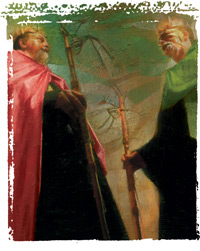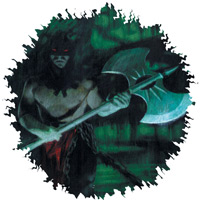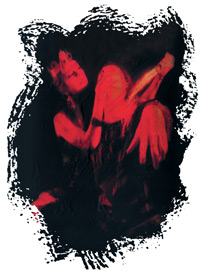Knightmare Chess - An Introduction
by Steffan O'Sullivan
"Do you play chess?"
 Steve Jackson asked me this in December, 1995. I replied warily that I had
played a lot in my youth, but only occasionally now. With Steve, one has to be
careful – he likes to play and win lots of different games. Did I really
want to be trounced by Steve at chess?
Steve Jackson asked me this in December, 1995. I replied warily that I had
played a lot in my youth, but only occasionally now. With Steve, one has to be
careful – he likes to play and win lots of different games. Did I really
want to be trounced by Steve at chess?
But my suspicions were totally unfounded. He merely wanted me to playtest a new game that Steve Jackson Games is producing: Knightmare Chess. Once he told me the basics, I didn't hesitate at all. It sounded like something I'd love. And it is.
Knightmare Chess is easily my favorite game of the past year, the one I've played more than any other game I've gotten – and I've gotten some good games this past year! It combines the pure strategies of chess with a wealth of diverse options. Knightmare Chess introduces some randomness into chess, but in a very good, semi-controlled sense. There are no dice. But there are cards.
And what cards! Knightmare Chess consists of 80 cards, attractively illustrated by Rogerio Vilela, each of which allows you to break a given rule of chess. Usually these are one-shot options – you may move a knight as if it were a queen for one turn, for example – but some last the whole game: a knight can become the new king, which must be checkmated to win the game!
So what makes this so great? It's hard to describe the action of the game. I hadn't played chess much in many years because it's a bit too cerebral and abstract for me – I tend to go with lighter games with more flavorful backgrounds these days. But I still have a soft spot in my heart for chess, one of my first "favorite" games.
Knightmare Chess introduces lightness and flavor into chess, and that's a combination I can't resist. Apparently others can't either, even those who don't know chess well. I've played Knightmare Chess with chess novices who can't get enough of the game. In fact, the only group of people who might not like this game are very hard core chess nuts, who might consider it a desecration. It's not, of course – you can tell the designers love chess as much as I do. I consider it more a tribute to chess than a parody.
Knightmare Chess has 80 cards, complete in one box. The rules are simple and plainly written. In the basic game, each player takes roughly half the deck, and builds a 150-point hand. (Point values range from two to ten per card, with the average around six points. So 150 points will usually be 20-30 cards.) You shuffle your individual deck, deal out five cards to yourself, then begin a game of chess. You may play a card each move, and again on your opponent's move, if desired, and if you have an appropriate card in your hand. Redraw up to a five-card hand after you play any card.
The rules also give an option for simply playing from one big stack of cards – no deckbuilding stage at all in that variant, just deal 'em out and refill from a common draw pile. And if both players have their own decks, you can each custom-design a deck from your own cards and meet head-to-head! This is one of the most exciting ways to play the game, as you aren't limited in your deck-building choices.
Knightmare Chess creates devious playing habits, no doubt about it. When your opponent makes a move that appears to have no bearing on his strategy, watch out! He probably has a card that he's setting up. This can range from the fairly innocuous Madman (move a pawn as if it were a King in Checkers!) to the more deadly Fireball (your piece explodes and is removed from the board, but it takes all pieces on the eight adjacent squares with it!). And if you've pinned his pawn in his seventh rank, so it can't advance to promote, and he doesn't look upset, beware! He may have Crab, which will allow his pawn to move forward diagonally, avoiding your blocking piece, or, much worse, Breakout, which allows him to capture by moving his pawn straight ahead!
A game of Knightmare Chess never bogs down. Games are much shorter than in regular chess, because there's not much point in slow, patient, long-term planning – any plan more than three moves ahead will probably be short-circuited by your opponent's cards, if not by your own . . .
By my own? Yes, I've played a card now and then that had repercussions I hadn't fully considered earlier. Under Elf Hill is a delightful card, for example: remove your King from the board for a turn, and he reappears on any vacant space along the edge! Delightful, yes, but if you just play the card as a reaction to "Check" without thinking out his reentry point, I can assure you from experience that you may be in worse trouble than removing the check in a more conventional manner . . .

Strategy and Deck-Building Hints
The Knightmare Chess rules urge you to build your deck according to your playing style. If you favor the Queen, include a lot of Queen cards, etc. Well, yes, but I'd like to add that you should always include a couple of "back doors." I mean cards that will get you out of a potential checkmate situation, such as Chaos, Under Elf Hill or Knightmare. I also think it never hurts to include a card or two that will bring back a lost piece. This is especially important against an opponent who likes to trade pieces!
 Do you go for a lot of low-point cards, or just a smaller number of
high-point cards? Or find a happy medium? I can't answer this one definitively,
but keep in mind that the more cards you have, the less likely you'll get the
one you really want at a given time. And just to keep you from straying too far
in the other direction, I'll also add that the fewer cards you have, the quicker
you'll run out, and there's no reshuffling the deck in Knightmare
Chess . . .
Do you go for a lot of low-point cards, or just a smaller number of
high-point cards? Or find a happy medium? I can't answer this one definitively,
but keep in mind that the more cards you have, the less likely you'll get the
one you really want at a given time. And just to keep you from straying too far
in the other direction, I'll also add that the fewer cards you have, the quicker
you'll run out, and there's no reshuffling the deck in Knightmare
Chess . . .
In my experience, it's best not to expect a quick kill. That is, if you go for all eight- to ten-point, heavy-duty crushing cards, you still can't really expect to win quickly. This is because your opponent probably has enough escape-hatch cards to get out of your traps. He can then use his offensive cards to put you completely at his mercy if you run out of cards quickly. Best to have a more balanced deck.
Many cards are better in the late mid-game or end-game stages. What if you draw three or four of these in your initial draw of five cards? Under Elf Hill isn't much good until the board's been cleared a bit, for example. Do you discard these, or hang on to them?
Tough question, but I'd say hang on to at least two of them. That still gives you three cards to play with in the early stages of the game, and that should be plenty. Discarding an end-game card nearly always causes regrets later – don't do it if you can possibly avoid it.
As for chess strategy, go ahead and play your normal game. That is, if you favor Queen Pawn openings, continue to use them. Just don't hold any long term plans too closely – be flexible, as your opponent's cards will change the game dramatically when you least expect it.
We tend to trade more in this game than in regular chess. For one thing, a knight in the center of the board is more threatening in Knightmare Chess than normal chess because there are cards that will allow him to strike your back row – and explode! So get rid of any threatening-looking piece – it's okay to trade. There are so many cards that will allow you to return captured pieces that it's actually nice that there are some captured pieces to bring back! Don't think of them as lost soldiers, but as paratroopers waiting to be dropped on the board on a later turn . . .

Variant
Here's an interesting common deck variant for those with nerves of steel. It takes courage to stand up there and see what's coming, and try to combat it anyway!
Do not divide the deck, but shuffle all 80 cards together. Do not deal any cards to either player. Instead, let White take his first move, then turn three cards over, face up, next to the board. Black looks the cards over, and chooses one. He then takes his move, playing the card he chose or not, as he sees fit.
 At the beginning of White's turn, turn over another card so there are three
showing again. White now chooses a card, and takes his turn. He may play his
card or hold onto it. Black may play his card, if it's an appropriate type,
during or after White's move.
At the beginning of White's turn, turn over another card so there are three
showing again. White now chooses a card, and takes his turn. He may play his
card or hold onto it. Black may play his card, if it's an appropriate type,
during or after White's move.
At the beginning of Black's move, he discards his card if he still has it. It's out of the game. Black then turns over another card so there are three showing, and chooses one. Black makes his move, with or without a card, and White may play a card in response if the card can be played that way.
And so on. Each turn begins by discarding the card held, if any, then turning over a new card to reveal three cards, drawing one, and making your move. You will always have three cards to choose from. You will always have one card, and only one card, as you begin your move. You will always see two cards you're leaving for your opponent as you make your move.
You may take a card that you cannot legally play, such as a card that affects your Queen when your Queen has been captured. This may be done to prevent your opponent from getting the card.
This variant makes for a very nerve-wracking game, as you can see in advance what your opponent can do to you, and you hope he doesn't see the same possibilities. Relax. He probably sees something more deadly that you hadn't considered . . .
This article originally appeared in Pyramid #21













